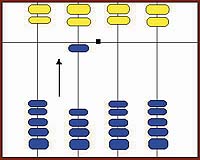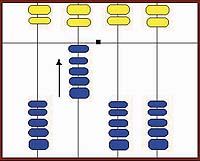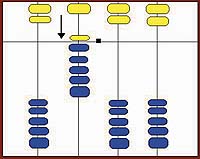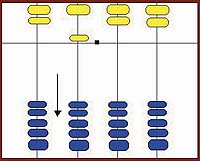| |
 Later: "Abacus Abu,
the abacus, is a mechanical aid used for counting; it is not a
calculator in the sense we use the word today. The person operating the
abacus performs calculations in his or her mind and uses the abacus to
keep track of the sums, the carrys, etc. It was devised by ancient
merchants, who, for trading goods, not only needed a way to count goods
bought and sold, but also required to quickly calculate the costs. Later: "Abacus Abu,
the abacus, is a mechanical aid used for counting; it is not a
calculator in the sense we use the word today. The person operating the
abacus performs calculations in his or her mind and uses the abacus to
keep track of the sums, the carrys, etc. It was devised by ancient
merchants, who, for trading goods, not only needed a way to count goods
bought and sold, but also required to quickly calculate the costs.  Until numbers were invented, these counting devices were used to make
everyday calculations. The first counting board probably involved
drawing lines in the sand (the space between 2 lines would represent the
units 10s, 100s, etc.) and placing small pebbles within those lines, as
place holders representing numbers. The need for durability gave way to
wooden boards, who gave way to marble and metal tablets. The oldest
surviving counting board is the Salamis Tablet, used by the Babylonians
close to 300 BC and rediscovered in 1899 on the island of Salamis. It is
a slab of marble marked with 2 sets of eleven vertical lines (10
columns), a blank space between these, a horizontal line crossing each
set of lines and Greek symbols along the top and the bottom." Until numbers were invented, these counting devices were used to make
everyday calculations. The first counting board probably involved
drawing lines in the sand (the space between 2 lines would represent the
units 10s, 100s, etc.) and placing small pebbles within those lines, as
place holders representing numbers. The need for durability gave way to
wooden boards, who gave way to marble and metal tablets. The oldest
surviving counting board is the Salamis Tablet, used by the Babylonians
close to 300 BC and rediscovered in 1899 on the island of Salamis. It is
a slab of marble marked with 2 sets of eleven vertical lines (10
columns), a blank space between these, a horizontal line crossing each
set of lines and Greek symbols along the top and the bottom."
 "An abacus (picture
1) is a grid divided into two decks — upper and lower — by a
horizontal wire running across. The place values, shown on vertical
lines running across, increase from right to left. Decimal place values
increase from left to right. The upper deck has two beads in each
vertical line and the lower deck has five beads in each line. To count
one (picture 2), move one bead on the 1's line from the lower deck to
the middle bar (deck divider). To count 2, move 2 beads up from this
deck. "An abacus (picture
1) is a grid divided into two decks — upper and lower — by a
horizontal wire running across. The place values, shown on vertical
lines running across, increase from right to left. Decimal place values
increase from left to right. The upper deck has two beads in each
vertical line and the lower deck has five beads in each line. To count
one (picture 2), move one bead on the 1's line from the lower deck to
the middle bar (deck divider). To count 2, move 2 beads up from this
deck.  All values are read from the middle bar. After moving 5 beads up
(picture 3) from the lower deck, a carry to the upper deck (picture 4)
and a reset of the lower deck (picture 5) will complete counting 5. All values are read from the middle bar. After moving 5 beads up
(picture 3) from the lower deck, a carry to the upper deck (picture 4)
and a reset of the lower deck (picture 5) will complete counting 5.
In actual operation, the
fifth bead in the lower deck is never moved, the carry-reset operation
is performed in one motion. We discover that every bead in the lower
deck symbolises 1 and every bead in the upper deck symbolises 5."
(to be continued; write at
The Tribune or adityarishi99@yahoo.co.in)
|

